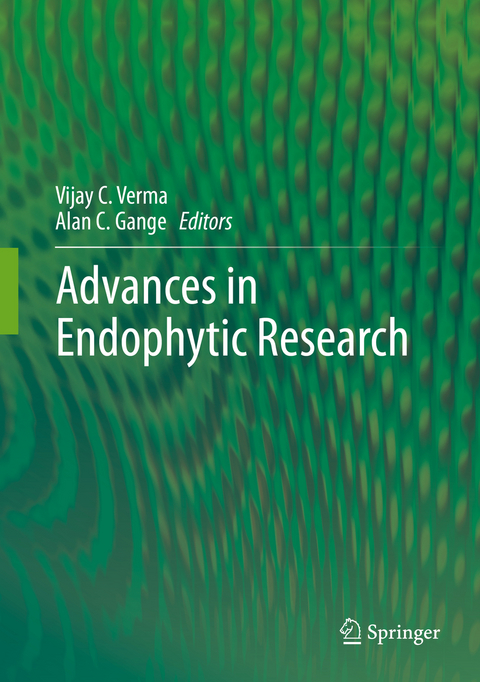
Advances in Endophytic Research
Springer, India, Private Ltd (Verlag)
978-81-322-1574-5 (ISBN)
Vijay C. Verma, PhD chandravcv@gmail.com Dr. Vijay Verma joined Department of Botany, Banaras Hindu University, India for his PhD, which he obtained in 2009. During his PhD, Dr. Verma explored the endophytic microbes associated with neem plant and their ecological roles for getting inexplicable host-endophyte interactions. He has also investigated the potential of endophytes in production of host-specific compounds and reported for the first time ever that Azadirachtin and Piperine are the two most important molecules that can be exclusively sourced from their respective host and can also be produced by fungal endophytes of the same host plants. He visited Technical University of Dortmund as DAAD fellow, and recently has been recognized as Fast Track Young Scientist by Department of Science and Technology, India. He has published more than 25 publications in the journals of international repute and edited one book. Alan Christopher Gange, PhD a.gange@rhul.ac.uk Prof. Alan Gange obtained his PhD from University of London, UK in 1985. In 1992, he joined the Royal Holloway University of London as lecturer and became professor of microbial ecology in 2007 and currently serving as Head of the Department, School of Biological Sciences, Royal Holloway University of London. He has over 30 years of research and teaching experience. He has published more than 100 peer reviewed papers in highly reputed international journals including ‘Science’. His research interest is to study the multitrophic interactions which affect the diversity and structure of plant communities. He is specifically interested in how non-pathogenic fungi in plants affect the insects.
Part 1: Ecology and Biodiversity.- Chapter 1.Diversity and ecology of endophytic and epiphytic fungi of tree leaves in Japan: a review.- Chapter 2. Endophytic actinobacteria: diversity and ecology.- Chapter 3.Foliar fungal endophytes in herbaceous plants: a marriage of convenience?.- Part 2: Entomopathogenic endophytes.- Chapter 4. Entomopathogenic and nematophagous fungal endophytes .- Part 3: Host-endophyte interactions.- Chapter 5. Interactions of meristem-associated endophytic Bacteria.- Chapter 6. Unraveling the dark septate endophyte functions: Insights from the Arabidopsis model .- Chapter 7. Asexual endophytes of grasses: Invisible symbionts, visible imprints in the host neighborhood .- Part 5: Bioactive compounds from endophytes.- Chapter 8 . Microbial endophytes their resilience for innovative treatment solution to neglected tropical diseases .- Chapter 9. Endophytes and plant secondary metabolite synthesis: molecular and evolutionary perspective.- Chapter 10. Endophytes as a novel source of bioactive new structures .- Chapter 11.Host-mimetic metabolomics of endophytes: looking back into the future.- Chapter 12. Myconanosynthesis: Redefining the role of microbial endophytes .- Part 6: Bio-control and bioremediation.- Chapter 13.Biological control of insect-pest and diseases by endophytes.- Chapter 14. Biocontrol and bioremediation: two areas of endophytic research which hold great promise.- Chapter 15. Biosourcing endophytes as biocontrol agents of wilt diseases.-Chapter 16. Ecology and functional potential of endophytes in bioremediation: a molecular prospective.- Chapter 17 Ecological aspects of endophyte-based biocontrol of forest diseases .- Chapter 18 Endophyte mediated biocontrol of herbaceous and non-herbaceous plants .- Part 7: Endophytes and cancer.- Chapter 19. Implication of endophytic metabolite and their derivatives in cancer chemotherapy: a prospective study.- Chapter20. Endophytic fungi: novel sources of anticancer molecules.- Part 8: Future challenges.- Chapter 21. A functional view of plant microbiomes: Endosymbiotic systems that enhance plant growth and survival.- Chapter 22. Microbial endophytes: future challenges.
| Zusatzinfo | 35 Illustrations, color; 51 Illustrations, black and white; XXIII, 454 p. 86 illus., 35 illus. in color. |
|---|---|
| Verlagsort | New Delhi |
| Sprache | englisch |
| Maße | 178 x 254 mm |
| Themenwelt | Naturwissenschaften ► Biologie ► Mikrobiologie / Immunologie |
| Naturwissenschaften ► Biologie ► Mykologie | |
| Naturwissenschaften ► Biologie ► Ökologie / Naturschutz | |
| Schlagworte | Bioactive Compounds • Bio-control • bioremediation • Evolutionary systematics • microbes |
| ISBN-10 | 81-322-1574-5 / 8132215745 |
| ISBN-13 | 978-81-322-1574-5 / 9788132215745 |
| Zustand | Neuware |
| Haben Sie eine Frage zum Produkt? |
aus dem Bereich


